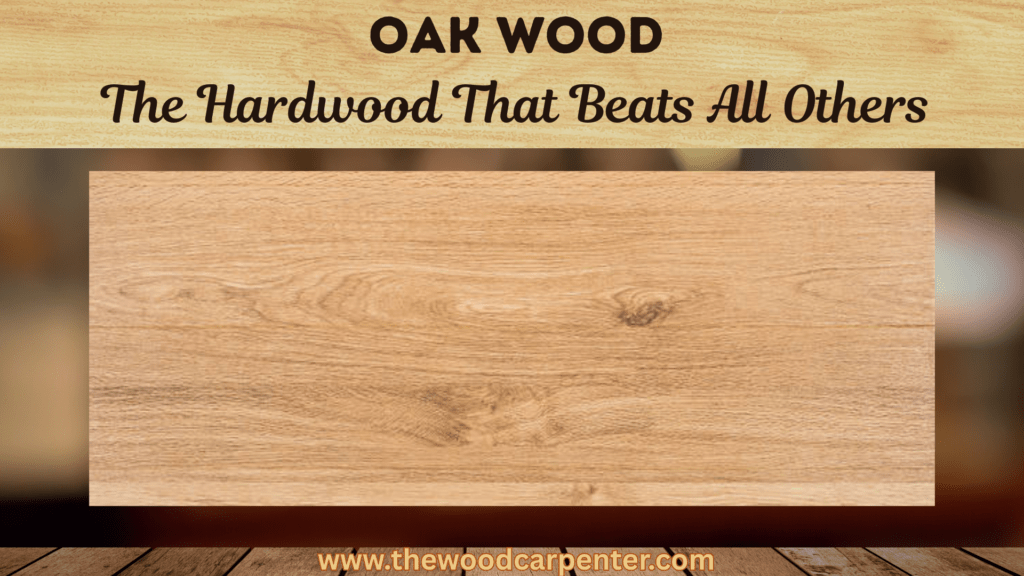
Oak wood is one of the most famous and useful hardwoods in the world. People love it for its strength, long life, and beautiful grain pattern. For centuries, woodworkers, builders, and furniture makers have chosen oak because it looks great and lasts a long time.
It’s used in many different ways and never goes out of style. In this guide, we’ll cover everything about oak—from its types and features to its uses and care tips. At the end, we’ll also answer some common questions about this amazing wood.
Types and Origins of Oak
Oak trees belong to the Quercus family, which has over 600 species. They mainly grow in the Northern Hemisphere—in places like North America, Europe, and parts of Asia. The two main types used most often are:
White Oak (Quercus alba) – Mostly found in North America, white oak is very strong and resists water well. Its tight grain stops moisture from getting in, making it perfect for outdoor furniture, flooring, and barrels for whiskey and wine.
Red Oak (Quercus rubra and similar species) – Also common in North America, red oak has a more open grain and is not as water-resistant as white oak, but it’s still excellent for furniture and indoor flooring.
In Europe, English oak (Quercus robur) and sessile oak (Quercus petraea) have been used for centuries to build ships and buildings. There’s also the cork oak (Quercus suber), which is grown mainly for its bark to make cork, not for its wood.
Physical Characteristics of Oak Wood
Color and Grain
Oak wood comes in many shades. The outer part of the tree, called sapwood, is usually pale yellow or light beige. The inner part, called heartwood, can be light brown to dark reddish-brown. Oak has a coarse, noticeable grain with clear growth rings, giving it a natural and attractive look.
Hardness and Density
Oak is a strong hardwood that scores high on the Janka hardness scale, which measures how well wood resists dents and wear. White oak scores about 1360 lbf, and red oak scores about 1290 lbf. This hardness makes it a great choice for furniture, floors, and other items that get a lot of use.
Strength and Durability
Oak is dense (about 0.65–0.75 grams per cubic centimeter), which makes it very strong. Its high tannin content helps protect it from insects and rot. White oak’s tight grain also makes it more water-resistant, which is why it’s often used for outdoor furniture and barrels.
Workability
Even though oak is hard, it can be shaped with both hand tools and machines. It sands and planes smoothly, but its open pores may need filling to get a perfectly smooth finish. Oak can also be softened with steam to make it bend for curved designs.
Uses of Oak Wood
Oak is one of the most versatile woods and is used in many areas—from homes to industry to crafts.
Furniture – Oak is a top choice for making strong, long-lasting pieces like tables, chairs, cupboards, and beds. It takes stain well and develops a rich, attractive look (patina) over time, making it great for both classic and modern designs.
Flooring – Because it’s hard and durable, oak is perfect for floors that need to handle years of heavy foot traffic. Both white and red oak floors are tough and add a warm, welcoming feel to a home.
Construction – In the past, oak was widely used for building frames, beams, and detailed woodwork. Many old buildings still have oak beams that are in excellent condition centuries later.
Barrels and Cooperage – White oak’s tight grain makes it leak-proof, which is why it’s the top choice for barrels used to age wine, whiskey, and other drinks. The wood also adds unique flavors during the aging process.
Shipbuilding – Before the 1900s, oak was the main wood for ship hulls because it’s strong and naturally water-resistant.
Musical Instruments – Oak’s density and sound quality make it useful for making drums and other percussion instruments.
Other Uses – Oak bark is high in tannins, which are used in tanning leather. Oak galls have been used to make ink, and acorns can be used as feed for animals.
Care and Maintenance
Oak is naturally strong and long-lasting, but the care it needs depends on how it’s used.
Indoor Use – Keep oak clean by regularly dusting and polishing it with proper wood care products. This helps protect the finish and prevents the wood from drying out.
Outdoor Use – White oak is naturally resistant to moisture, but it’s still best to treat it with wood oil or sealant every so often. This adds extra protection from rain, sunlight, and weather damage.
Avoiding Damage – Don’t expose oak to too much moisture, harsh chemicals, or direct sunlight for long periods. This can cause warping, cracking, or fading.
Refinishing – Sanding and refinishing oak furniture or floors from time to time can bring them back to their original beauty.
Advantages of Oak Wood
Strength and Durability – Oak is very strong and dense. On the Janka hardness scale, white oak scores about 1360 lbf and red oak about 1290 lbf, meaning they resist dents and scratches better than many other hardwoods.
Oak’s high tannin levels also help protect it from insects and rot, especially in white oak with its tight grain.
Attractive Appearance – Oak has a bold, coarse grain with visible growth rings and patterns that many people love. The color can range from pale beige to golden brown or reddish-brown, giving it warmth and character.
It also takes stain and finish well, so you can customize its look.
Versatility – Oak can be used for furniture, floors, cabinets, beams, barrels, and even musical instruments. It works well with both hand tools and machines, even though it’s quite hard.
Long Life – With the right care, oak items can last for decades—or even centuries. Indoors, it needs only simple cleaning and polishing. Outdoors, white oak’s natural water resistance means less upkeep.
Over time, oak develops a rich patina that many find even more beautiful.
Disadvantages of Oak Wood
Cost and Availability – Oak is more expensive than many other woods, especially softwoods like pine. Because it grows slowly and is in high demand, it can be harder to find in some areas. Sustainable sourcing is also important to protect certain oak species.
Heavy Weight – Oak’s density makes it strong but also heavy. This can make it harder to move or install, and it can increase transport costs.
Moisture Sensitivity – While white oak resists water well, red oak and some other types are more prone to rot and insect damage if not protected. Oak can also expand or shrink with changes in humidity, which might cause warping or cracking if it’s not treated properly.
Workability Challenges – Oak’s hardness can make it tougher to cut and shape than softer woods. Its open pores may need filling for a smooth finish, and it can wear down tools faster. It can be bent with steam, but it’s not as flexible as some other hardwoods like ash.
Oak Wood vs. Other Hardwoods
| Feature | Oak Wood | Maple | Birch | Teak |
| Hardness (Janka) | High (1290-1360 lbf) | Slightly lower than oak | Similar to maple | Lower than oak but very durable |
| Grain & Appearance | Prominent, coarse grain; warm tones | Fine, uniform grain; lighter color | Fine grain, pale color | Interlocking grain; oily, golden brown |
| Durability | Very durable, resistant to wear | Durable, but prone to scratches | Durable but softer than oak | Extremely durable, highly rot-resistant |
| Moisture Resistance | White oak very resistant; Red oak less | Moderate | Moderate | Excellent, commonly used outdoors |
| Cost | Higher cost | Generally less expensive | Typically cheaper | More expensive than oak |
| Workability | Harder to work, requires filler | Easier to machine | Easy to work | Cuts easily but oily; needs drying |
| Common Uses | Furniture, flooring, barrels, construction | Furniture, flooring, cabinetry | Plywood, furniture, cabinetry | Outdoor furniture, decking, boatbuilding |
Frequently Asked Questions (FAQs) About Oak Wood
Q: Is oak wood a hardwood or softwood?
A: Oak is a hardwood. It comes from broad-leaf trees that lose their leaves in winter, not from evergreen conifers, which are softwoods.
Q: What’s the difference between red oak and white oak?
A: White oak has a tighter grain, making it more water-resistant and decay-resistant—great for outdoor projects and barrels. Red oak has a more open grain, so it’s mostly used indoors for furniture and floors.
Q: How hard is oak wood?
A: Oak is very hard. On the Janka hardness scale, white oak scores about 1360 lbf and red oak about 1290 lbf, meaning both resist dents and scratches well.
Q: Can oak be used outdoors?
A: Yes—especially white oak, which naturally resists water. With proper care and treatment, it can last a very long time outdoors.
Q: Does oak change color over time?
A: Yes. Oak often darkens as it ages and is exposed to sunlight, developing richer golden or amber tones.
Q: Is oak sustainable?
A: Many oak forests are managed sustainably, but the trees grow slowly. Buying oak that is certified by a sustainable forestry program helps protect the species and the environment.
Final Thoughts:
Oak wood is a perfect mix of beauty, strength, and long life. From historic buildings to fine furniture to barrels aging some of the world’s best wines and whiskeys, oak has been trusted for centuries.
By learning about its types, features, and care, you can enjoy oak’s timeless charm for generations. Its durability, rich grain, and versatility ensure it will remain one of the most valued woods in the world.

